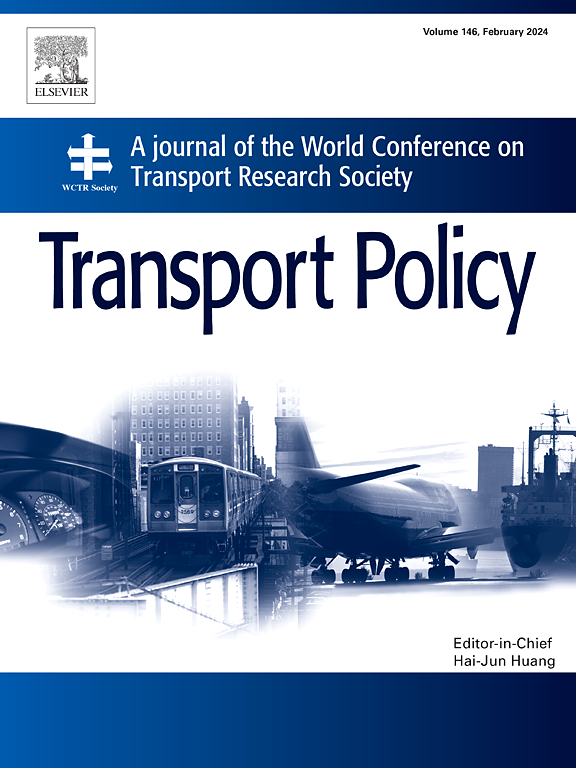Preparing for an agentic era of human-machine transportation systems: Opportunities, challenges, and policy recommendations
IF 6.3
2区 工程技术
Q1 ECONOMICS
引用次数: 0
Abstract
Human-Machine Transportation Systems (HMTS) refer to transportation systems where humans and machines interact to enable mobility. The history of humans creating and utilizing machines for transportation purposes dates back from the invention of the wheel to more recent innovations such as bicycles, automobiles, traffic signals, handheld navigation devices, asphalt pavers, and computer-aided design and management tools. In recent years, technological advancements have transformed machines from passive tools into more active participants, with humans increasingly delegating complex tasks and responsibilities to them. While these advancements have revolutionized mobility, their siloed, uncoordinated implementation has also introduced critical challenges, including urban sprawl, high fatalities, environmental degradation, and worsened societal disparity.
The recent advancements in machine learning, robotics, communication, and computing technologies prompt the emergence of agentic transportation systems (ATS) to potentially address these chronic issues and transform how people access resources and opportunities. In ATS, intelligent machines serve as autonomous intermediaries, facilitating the interactions among humans and between humans and infrastructure. From this new standpoint, early-stage ATS—such as autonomous vehicles, on-demand ridesharing platforms, generative design tools, construction robots, and anomaly detection equipment—have already begun to enter society, calling for an understanding about whether the current research and practice in transportation planning and engineering are ready for ATS. A review of recent literature reveals four main categories of research: (1) co-visioning, co-planning, and co-design; (2) co-construction and co-maintenance; (3) co-control, co-operation, and co-management; and (4) co-usage and co-consumption. The review suggests a significant lack of studies on the proactive integration of agentic machines within and across individual lifecycle phases, risking severe and irreversible consequences. Accordingly, the paper proposes a framework to guide the development of ATS to be justifiable, inclusive, and adaptable (JIA) and ensure the intelligence in and of the next-generation HMTS to be genuinely human-centered and societally beneficial.
为人机交通系统的代理时代做准备:机遇、挑战和政策建议
人机运输系统(HMTS)是指人与机器相互作用以实现移动性的运输系统。人类创造和利用交通工具的历史可以追溯到轮子的发明,到最近的发明,如自行车、汽车、交通信号、手持导航设备、沥青摊铺机以及计算机辅助设计和管理工具。近年来,技术进步使机器从被动的工具转变为更积极的参与者,人类越来越多地将复杂的任务和责任委托给它们。虽然这些进步彻底改变了流动性,但其孤立、不协调的实施也带来了严峻的挑战,包括城市蔓延、高死亡率、环境退化和社会差距加剧。最近机器学习、机器人技术、通信和计算技术的进步促使代理运输系统(ATS)的出现,有可能解决这些长期问题,并改变人们获取资源和机会的方式。在ATS中,智能机器作为自主中介,促进人与人之间以及人与基础设施之间的互动。从这个新的角度来看,早期的自动驾驶汽车——如自动驾驶汽车、按需拼车平台、生成式设计工具、建筑机器人和异常检测设备——已经开始进入社会,这需要我们了解当前交通规划和工程方面的研究和实践是否已经为自动驾驶汽车做好了准备。对近期文献的回顾揭示了四个主要研究类别:(1)共同愿景、共同规划和共同设计;(2)共建共维;(三)共同控制、合作、共管;(4)共用共耗。该综述表明,在个体生命周期内和跨生命周期主动整合代理机器的研究严重缺乏,有可能产生严重和不可逆转的后果。据此,本文提出了一个指导自动驾驶系统发展的框架,使其具有合理性、包容性和适应性(JIA),并确保下一代自动驾驶系统的智能真正以人为本,对社会有益。
本文章由计算机程序翻译,如有差异,请以英文原文为准。
求助全文
约1分钟内获得全文
求助全文
来源期刊

Transport Policy
Multiple-
CiteScore
12.10
自引率
10.30%
发文量
282
期刊介绍:
Transport Policy is an international journal aimed at bridging the gap between theory and practice in transport. Its subject areas reflect the concerns of policymakers in government, industry, voluntary organisations and the public at large, providing independent, original and rigorous analysis to understand how policy decisions have been taken, monitor their effects, and suggest how they may be improved. The journal treats the transport sector comprehensively, and in the context of other sectors including energy, housing, industry and planning. All modes are covered: land, sea and air; road and rail; public and private; motorised and non-motorised; passenger and freight.
 求助内容:
求助内容: 应助结果提醒方式:
应助结果提醒方式:


